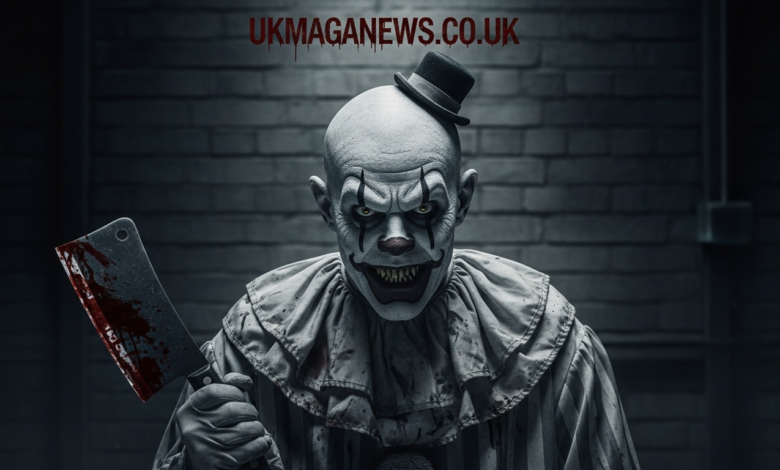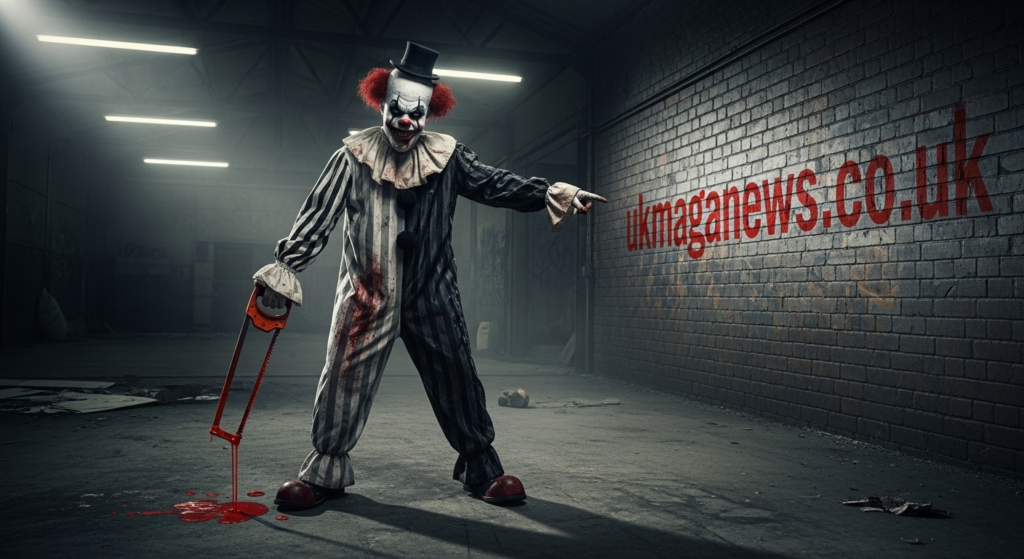The Evolution of Art the Clown: From Horror Icon to Cultural Phenomenon

Introduction to Art the Clown
Art the Clown is a fictional character who has carved a unique niche within the horror genre since his inception. Originating from the short film “Terrifier,” released in 2016, Art is a malevolent figure characterized by his white face, exaggerated clown makeup, and a sinister, almost playful demeanor. Unlike traditional clowns, who often evoke laughter, Art symbolizes a deeper and more unsettling psychological fear, embracing the dark aspects of clown imagery and folklore. His stark appearance and unnerving behavior have contributed to his rise as a horror icon.
The character was first introduced in the 2013 anthology film “All Hallows’ Eve,” which showcased his menacing antics. However, it was in “Terrifier” that Art the Clown gained prominence, solidifying his place in modern horror culture. The film not only highlighted his relentless and brutal methods of killing but also portrayed him as a captivating character who is as intriguing as he is terrifying. Art’s absence of dialogue adds to his enigmatic nature, allowing his actions to speak volumes, making horror enthusiasts both terrified and fascinated by him.
As Art the Clown continues to appear in sequels and spin-offs, he has transitioned from a niche horror character to a cultural phenomenon. His influence permeates various aspects of popular culture, inspiring a plethora of fan artwork, merchandise, and discussions that extend beyond the screen. The evolution of Art underscores a significant shift in horror themes, where audiences increasingly gravitate towards complex antagonists who challenge traditional narrative forms. As such, Art the Clown stands as a testament to the evolving landscape of horror cinema, captivating audiences with his sinister charm and unrelenting terror.
The Creation of Art the Clown
Art the Clown emerged as a compelling figure in the horror genre, thanks to the creative vision of Damion Leone. Initially introduced in the short film “Terrifier,” Art’s character encapsulates a unique blend of grotesque humor and unrelenting menace, captivating audiences and becoming an iconic horror figure. The design process behind Art the Clown was heavily influenced by Leone’s personal experiences and artistic aspirations. He aimed to create a character that would stand apart from conventional horror villains, combining the traits of a clown with elements of the macabre.
Art’s appearance is one of the most distinctive aspects of his character, characterized by exaggerated features that evoke both curiosity and fear. His chalk-white skin, drawn-on smile, and razor-sharp teeth emphasize his unnerving presence. The choice of a clown—often associated with childhood innocence—juxtaposed with the horror of his actions fosters a chilling dissonance. Leone’s intention was to revisit the traditional clown archetype, stripping it of its joviality and infusing it with ominous undertones.
Influences from various horror films and literature are evident in Art’s characterization. For instance, elements reminiscent of classic figures such as Pennywise the Clown can be noted, yet Leone crafts Art as a distinctly original entity. The character’s silent disposition amplifies his sinister aura, allowing audiences to project their own fears onto him. The meticulous attention to design detail, including the iconic black-and-white costume, sets Art apart visually and thematically. These elements collectively contribute to Art’s menacing presence and underline the broader narrative of fear in the modern horror landscape.
Art the Clown in ‘Terrifier’ and ‘Terrifier 2’
Art the Clown, portrayed by David Howard Thornton, made his significant debut in the 2016 film ‘Terrifier,’ helming the narrative as a grotesque and sadistic figure. The film showcases Art’s unrelenting pursuit of his victims, marked by a chilling indifference to their suffering. Notably, scenes such as the infamous “saw” sequence exemplify his brutal style, solidifying Art as a menacing figure in contemporary horror cinema. Critics acknowledged the film’s raw visual style and its return to practical effects, which starkly contributes to the realism of Art’s heinous acts. These elements provide audiences with an intense horror experience, elevating the overall impact of the character.
The sequel, ‘Terrifier 2,’ released in 2022, further develops Art’s character and expands the narrative scope. Critics heralded this installment for its increased ambition and execution, allowing Art to transition from a mere slasher villain into a more complex entity. Elaborate set pieces, particularly in scenes like his haunting of an unsuspecting girl on Halloween night, offered deeper psychological thrills while emphasizing Art’s position as both an antagonist and a cultural icon. Audiences engaged with Art in a new light, contemplating the deeper themes surrounding fear and the nature of horror itself.
The impact of both films on the horror genre is significant, revealing a resurgence of interest in slasher films characterized by stylized violence and a charismatic antagonist. Art the Clown has not only captured the attention of horror enthusiasts but has also sparked discussions in popular culture, paving the way for his emergence as a cult figure. Through both ‘Terrifier’ and ‘Terrifier 2,’ Art’s distinct aesthetic and psychopathic traits continue to resonate, leaving a lasting imprint on horror cinema.
Art the Clown’s Impact on Horror Culture
Art the Clown, the notorious figure from the “Terrifier” film series, has significantly reshaped the modern horror landscape since his debut. Emerging initially as a character in a short film, his unorthodox presentation and striking visual design resonated with audiences, creating a substantial impact on horror culture. Art’s horrifying visage, complete with his demonic grin and exaggerated clown makeup, taps into deeply-rooted fears associated with clowns, thereby revitalizing interest in slasher films and horror storytelling.
Art the Clown’s influence extends beyond mere aesthetics; he has become a symbol of the resurgence of independent horror films. By defying traditional horror tropes with his unique characterization and no-holds-barred approach to violence, Art embodies a trend where filmmakers experiment with unconventional narratives, ultimately attracting a dedicated fan base. This fan engagement is epitomized in events like horror conventions, where enthusiasts gather to celebrate the character’s brutal charm. Such interactions establish Art not only as a mere horror icon but also as a cultural phenomenon that invites discussion around the evolution of horror films.
The commercial landscape of horror has also evolved due to Art the Clown‘s allure, with merchandise ranging from masks to figurines becoming popular among fans. This growing market signifies a shift in how horror characters are marketed, transforming them into collectible icons. As horror storytelling broadens to include characters like Art, who amalgamate humor with relentless terror, it opens avenues for new narratives that reflect contemporary societal fears. Thus, Art the Clown’s role in horror culture illustrates not only a return to the slasher genre but also the collective desire for innovation in horror narratives, signifying a dynamic shift in cultural storytelling.
The Psychology of Fear: What Makes Art the Clown Terrifying
The character of Art the Clown serves as a compelling study in the psychology of fear. A significant aspect of his terrifying presence lies in the common association of clowns with innocence and joy, which starkly contrasts with Art’s violent, malevolent actions. This juxtaposition creates a dissonance that evokes a heightened sense of anxiety in viewers. Clowns have long embodied a duality, oscillating between whimsy and horror, which taps into deep-seated archetypes in human psychology. The phenomenon known as “coulrophobia,” or fear of clowns, stems from these unsettling discrepancies, as what is traditionally perceived as amusing transforms into a source of dread.
Art the Clown operates under the guise of playful antics, using humor to lure unsuspecting victims. His exaggerated features—glowing eyes, a wide, painted smile, and unsettling silence—further contribute to his terror. This is rooted in the uncanny valley theory, which suggests that entities that are nearly human elicit unease when they deviate from the norm. Art showcases exaggerated characteristics that blur the line between humor and horror, which serves to amplify his impact as a horror figure. The playful demeanor juxtaposed with ruthlessness not only perplexes victims but also shocks the audience, intensifying their emotional response.

Moreover, Art the Clown symbolizes mankind’s inherent fears and the darker aspects of human nature. His actions reflect the unpredictability of evil, with motivations that remain obscured. As he demonstrates a pleasure in causing suffering, Art engages viewers in a deeper existential contemplation of fear itself. The manifestation of this terrifying clown figure brings forth long-held fears of the unknown and uncontrollable—a testament to how Art the Clown has transcended traditional horror to become a complex cultural symbol of fear. His evolution encapsulates a confluence of psychological elements that both repel and fascinate, ensuring his place in the horror pantheon.
Art the Clown in Popular Media
Art the Clown, first introduced in the horror film “Terrifier,” has transcended his cinematic origins to become a multifaceted symbol within popular media. His menacing yet captivating persona has inspired an array of content beyond the realm of traditional films, establishing him as a significant figure in contemporary culture. This evolution is evident in various platforms, including comics, visual art, and a thriving community of fans.
Comic adaptations featuring Art the Clown have allowed fans to explore his character in new narratives, enhancing his backstory and expanding the lore surrounding him. These comics often incorporate dark humor and striking visuals, resonating with readers and appealing to the broader horror genre enthusiasts. The written word, combined with compelling artwork, has further solidified his status as an enduring figure in horror comics, creating a bridge between film and literature.
The influence of Art the Clown has also permeated the art world, where numerous artists have embraced him as a subject. Fan interpretations range from intricate paintings to digital artworks, showcasing the versatility of his grotesque yet fascinating design. This artistic engagement highlights a collective appreciation for horror aesthetics, inviting discussions about the role of fear and the macabre in art.
Moreover, Art the Clown’s impact is not limited to traditional forms of media. The character has inspired an array of cosplays, with fans replicating his distinctive appearance at conventions and events. This phenomenon indicates a deeper connection between the character and the audience, as participants embody and celebrate this chilling figure. Through these various expressions, Art the Clown has become not just a horror icon but a staple within popular culture, resonating with diverse audiences and thriving in multiple artistic realms.
Comparative Analysis: Art the Clown and Other Horror Icons
Art the Clown has solidly established himself as a formidable presence within the horror genre, paralleling iconic figures such as Pennywise, Freddy Krueger, and Jason Voorhees. Each of these characters originates from distinct narrative backgrounds but shares common thematic elements that provoke fear and unease among audiences. By examining their character designs and backstories, we can better understand the nuances that differentiate Art from his predecessors.
Art’s design is strikingly minimalist, characterized by a stark color palette of black and white, complemented by exaggerated facial features that evoke a disturbing sense of humor. This contrasts sharply with Pennywise, whose vibrant clown attire and playful demeanor mask a more sinister intent. While both are clowns, Pennywise is driven by a supernatural need to feed on fear and has the ability to shape-shift, amplifying the psychological terror he invokes. In comparison, Art engages in more visceral horror, focusing on gory realism, which heralds back to a more classical notion of slasher films.
Freddy Krueger embodies a dream-based terror, wielding the ability to invade the subconscious and manipulate reality while targeting his victims in their sleep. His backstory as a vengeful spirit serves to deepen the ideological complexities of his character. Conversely, Jason Voorhees represents a relentless force of nature; he is often demarcated by his iconic hockey mask and monstrous resilience, functioning primarily as a symbol of primal threats. Art the Clown, while lacking the ethereal and supernatural elements of Freddy or the purely physical terror exemplified by Jason, integrates a blend of absurdity and dread, shifting the traditional horror narrative. Furthermore, Art’s motivations seem less operatic compared to the other icons, focusing instead on chaos and sadistic enjoyment.
Ultimately, while Art the Clown exhibits elements like those of his counterparts, his unique aesthetic and approach to horror highlight the evolving landscape of fear-inducing characters in pop culture. Each figure offers different cultural critiques and resonates with varied anxieties, reflecting the changing fears of society through their respective narratives.
Fan Theories and Lore Around Art the Clown
The character of Art the Clown, introduced in the “Terrifier” series, has sparked a myriad of fan theories and lore that extend far beyond the narrative provided by the films. As a horror icon, Art has captivated audiences, leading to a community eager to explore deeper meanings and origins behind his menacing persona. Fans have taken to forums and social media to theorize about the character’s backstory, motivations, and the broader implications of his actions within the horror genre.
One prevalent fan theory posits that Art the Clown represents an embodiment of chaos and fear, drawing parallels to classic horror figures who challenge societal norms. This perspective encourages viewers to analyze Art’s role not merely as a killer but as a symbol of primal fears that haunt humanity. Many fans also enjoy speculating about Art’s origins, with some suggesting that he may be a reincarnation of a historical figure or a supernatural entity with ties to ancient folklore. Such theories invite an exploration of the intersection between Art the Clown and traditional horror motifs, enhancing the audience’s engagement with the character.
Furthermore, the phenomenon of fan fiction has significantly contributed to the expansion of Art’s storyline. Creative writers within the fan community construct narratives that delve into Art’s psyche, relationships, and adventures beyond the cinematic scope. These stories often place Art in various settings, intertwining him with other horror icons or fictional universes, leading to a vibrant tapestry of narratives that enrich the character’s lore. The interaction between fans and the original content fosters an engaging dialogue that enhances the mythos surrounding Art the Clown, showcasing a unique cultural phenomenon.
The Future of Art the Clown
As we look toward the future of Art the Clown within the horror genre, it is essential to recognize the character’s growing influence and potential evolution. The success of the “Terrifier” franchise has sparked considerable interest in additional projects featuring this unsettling figure. Anticipated developments may include sequels, spin-offs, or even crossover events that incorporate Art into broader horror narratives, allowing for creative storytelling possibilities that expand his sinister mythology.
Potential story arcs could delve deeper into Art’s backstory, exploring what shaped him into the horror icon known today. This exploration might lend itself to character development previously unseen in horror films, enabling audiences to engage with Art on a more profound level. By examining his origins, filmmakers can add layers of complexity, making him not only a terrifying figure but also a tragic one, fostering varied interpretations that could resonate with viewers beyond mere fright.
Furthermore, societal perceptions of horror are shifting, as audiences increasingly seek narratives that address contemporary issues. Themes such as fear in modern society, mental health, and the impact of violence can be woven into Art’s character arc. This alignment with current cultural conversations could bring a fresh perspective to the horror genre while catering to a more discerning audience. It is likely that the next iterations of Art the Clown will embrace these evolving themes, adapting the character to resonate with viewers’ experiences and concerns.
Ultimately, the future of Art the Clown lies in a delicate balance between maintaining the core elements that have defined him as a horror icon while also innovating to keep pace with societal changes and audience expectations. Fans and creators alike are anticipating what dimensions this iconic character will explore next, eagerly awaiting new narratives and deeper engagements with the chilling persona of Art the Clown.



